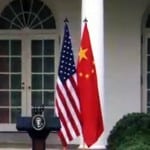China on June 29 submitted its Intended Nationally Determined Contribution (INDC) for reducing carbon emissions to the United Nations in preparation for the COP21 climate negotiations in Paris later this year. The INDCs are formal pledges toward a hoped-for binding agreement. The Chinese pledge builds on its November agreement with the U.S.
In its INDC, China pledged to cut its carbon emissions relative to its gross domestic product to 60% to 65% of 2005 levels by 2030. China had in 2009 pledged to cut emissions to 40% to 45% of 2005 levels by 2029, a level it is close to achieving—current emissions are 33.8% below 2005 levels.
To reach this goal, China plans to increase non-fossil generation to 20% of its generation mix, phase out problematic industries, and make low-carbon development a central national policy. Though coal will remain a major generation source, the INDC puts a priority on clean coal development and increasing efficiency to 300 grams of coal per kilowatt-hour.
The World Coal Association praised China’s approach in a press statement, but noted that progress on carbon capture will be necessary. “The announcement today means the climate talks in Paris later this year must recognise that low emission coal technologies will be crucial to achieving the world’s climate objectives,” CEO Benjamin Sporton said. “Without action on high efficiency low emission and carbon capture and storage technology it will be impossible to achieve the 2 degree target.”
Natural gas will get a boost—the INDC sets a goal of 10% by 2020—as will nuclear, hydro, and other renewables. Wind is targeted for 200 GW of installed capacity, while solar is targeted at 100 GW. The nation is now both the world’s largest manufacturer of solar panels and the largest market for solar power. Among an array of other measures outside the power sector, the INDC also sets a goal (though no target date is given) of setting up a national carbon emissions trading market.
China is the world’s largest emitter of carbon dioxide—in 2011, its CO2 emissions were about 50% higher than those of the U.S., the second largest emitter. Unlike the U.S., however, the Chinese government comes to the issue with broad popular support for reducing emissions. Air pollution has become a major social issue in China, and the central government has taken a number of sometimes-draconian measures to fight the problem, which nevertheless remains severe in many areas.
China had once argued that meaningful cuts in carbon emissions would handicap its long-term economic development, but political changes at home appear to have shifted the government’s attitudes.
Whether the U.S. will be able to make and meet similar commitments remains to be seen, as Republicans in Congress have vowed to do what they can to block a binding agreement. However, many of the critics of such an agreement have argued that the U.S. should not act before firm commitments from China. China’s targets in the INDC may serve to put opponents on the defensive.
—Thomas W. Overton, JD is a POWER associate editor (@thomas_overton, @POWERmagazine).










